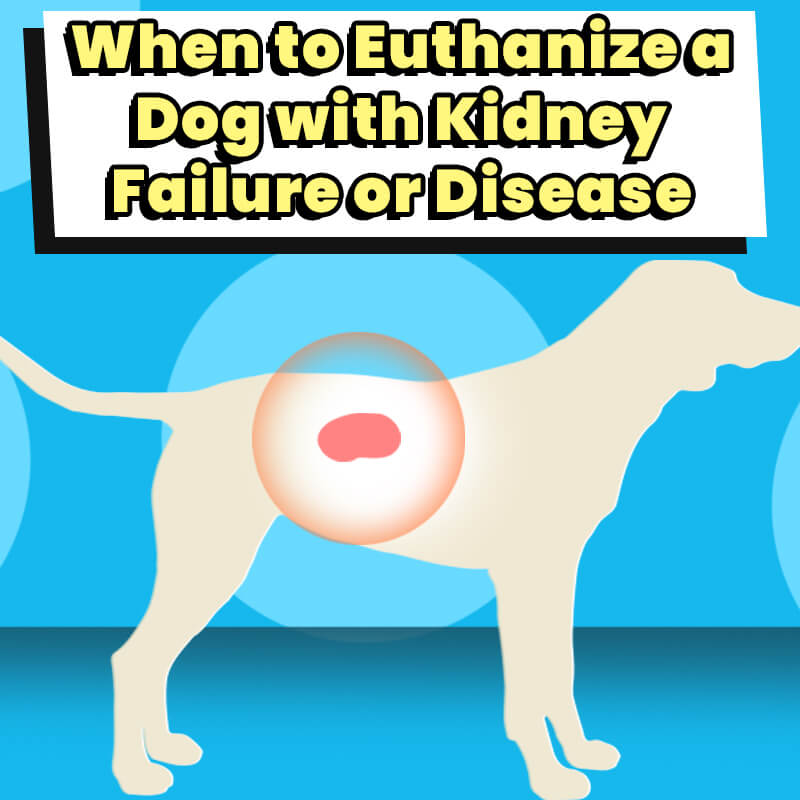Dog Kidney Failure
When your beloved dog is diagnosed with kidney failure, it can be difficult to know what to do. It can be difficult to understand when it is time to euthanize your pet. Deciding when to euthanize a dog with kidney failure is an emotionally draining and complex decision that owners must make with the help of their vet. This blog post will provide owners with information about the signs and symptoms of kidney failure, the treatment options available, and when to make the difficult decision to euthanize a dog with kidney failure.
Making the decision to euthanize a dog with kidney failure is one of the most difficult decisions a pet owner will ever have to make. It is important to talk to your vet and loved ones about your options and to weigh the pros and cons of treatment versus euthanasia. Ultimately, the decision should be based on what is best for the pet, not what is easiest for the owner.

The Kidneys—what Do They Do?
The kidneys are essential organs that play a major role in the body’s ability to function. They filter waste products from the bloodstream and help to regulate the body’s fluid and electrolyte balance. When a dog is suffering from kidney failure, it means that the kidneys are no longer able to perform their job properly.
An Overview of Kidney Disease In Dogs
Dog kidney failure is a serious medical condition that can often be difficult to manage and treat. The kidneys are responsible for eliminating toxins from the body and regulating the balance of electrolytes and fluids. When the kidneys are not functioning properly, toxins can build up in the body and cause a range of health issues.
When kidney failure is severe or has reached a point where it can no longer be managed, euthanasia may be the only option. It is important to understand the different stages of kidney disease and the signs that indicate a dog may be suffering from kidney failure in order to provide the best possible care and quality of life for your pet.
Early detection and treatment can help slow the progression of the disease and improve the prognosis for your beloved pet.
Read More: Last Days of Dog with Kidney Failure: What to Expect
What Are The Stages Of Dog Dying Of Kidney Disease?
In the early stages, a dog may display symptoms such as increased thirst, decreased appetite, and changes in urination. As the disease progresses, the dog may suffer from vomiting, dehydration, and a general decline in health. Owners should be aware of the signs and seek veterinary assistance as soon as possible. The following are the different stages of dog dying of kidney disease:
1. Early Stage: The dog may show increased thirst, decreased appetite, and changes in urination.
2. Middle Stage: The dog may exhibit increased vomiting, dehydration, and a general decline in health.
3. Late Stage: The dog may suffer from anemia, decreased cognitive function, and renal failure. At this point, the dog should be monitored closely and a veterinarian may recommend euthanasia to prevent further suffering. Euthanasia is a difficult decision and should only be done with the guidance of a veterinarian.
Symptoms of Kidney Disease In Dogs
Dog kidney failure is an incredibly serious condition that can lead to a difficult and painful life for a pet. Dogs who suffer from kidney failure will typically show the following signs:
1. Increased drinking and urination
2. Reduced appetite
3. Vomiting and diarrhea
4. Weight loss
5. Weakness and lethargy
6. Poor coat condition
7. Bad breath
8. Blood in the urine
9. Seizures
10. Inability to concentrate urine
If these symptoms are present, it is important to take the dog to the veterinarian for immediate treatment. If kidney failure is advanced, the dog may need to be euthanized to prevent further suffering. Veterinary staff will be able to help the pet owner make the best decision for their pet’s care.
Treatment For Acute Kidney Disease
When a dog is diagnosed with acute kidney failure, treatment will depend on the cause of the kidney disease and the severity of the condition. Treatment may include medications, fluids, dietary changes, and other supportive care.
However, if the condition is severe, it may be necessary to euthanize the dog to prevent further suffering. In general, if a dog is not responding to treatment, has severe and uncontrollable pain, or has a poor quality of life, euthanasia may be the best option.
It is important to discuss all potential treatment options with a veterinarian before deciding to euthanize a dog with acute kidney failure.
Read More: How to Euthanize a Dog with Over the Counter Drugs
Treatment For Chronic Kidney Disease
When a dog is diagnosed with chronic kidney disease, it is often a heartbreaking moment for pet parents. The disease, which is caused by damage or loss of kidney function, can cause a wide array of symptoms, including dehydration, weight loss, and anemia.
Treatment for chronic kidney disease can include medication, dietary changes, and fluid therapy. While these treatments can help manage the symptoms of the disease, they cannot reverse the damage done to the kidneys.
In some cases, the only option may be euthanasia, as the dog’s quality of life may be compromised by continued illness and suffering. Ultimately, the decision to euthanize a pet should be made by the pet parent and their veterinarian, as they are best able to assess the individual situation and determine what is best for the pet.
When To Euthanize A Dog With Kidney Failure

Euthanizing is an incredibly difficult decision for pet owners. Kidney failure affects a dog’s quality of life and can lead to a host of other complications. If a dog’s quality of life has deteriorated to an unacceptable level, or if the dog is in severe pain or discomfort, then it may be time to consider euthanasia.
Other factors that may be taken into consideration include the dog’s age, the rate of deterioration, the availability of medical treatment, and the dog’s ability to respond to treatment. It is important to remember that each dog is unique and each situation is different. The decision to euthanize should be made with the help and guidance of a veterinarian.
Read More: How Much Does it Cost to Euthanize a Dog at Home
Making The Decision To Euthanize Your Dog With Kidney Failure
Euthanizing a beloved pet with kidney failure can be one of the most difficult decisions to make. It is important to understand all the facts about your dog’s condition, and to be aware that in some cases, the decision to euthanize may be the most humane option. When making the decision, it is best to talk to your veterinarian and consider the quality of life your dog is currently experiencing.
If your dog is no longer able to enjoy activities they used to, and they are in pain or discomfort, it may be time to consider euthanasia. Additionally, if your dog’s health is in a state where it is unlikely to improve, or their life expectancy is short, it may be best to euthanize them and help them avoid a prolonged period of suffering. Ultimately, it is up to the pet parent to make the difficult decision, and ensure their pet’s comfort and dignity.
How Do You Comfort A Dog With Kidney Failure?
Following your veterinarian’s treatment plan is crucial. They will have tailored recommendations based on your dog’s specific condition and needs. This may include:
- Medications: These can help manage symptoms like nausea, vomiting, and anemia.
- Dietary changes: A special kidney diet will be essential to reduce the workload on their kidneys.
- Fluid therapy: This may be administered at home or at the vet clinic to keep your dog hydrated.
Additional comfort measures you can take at home include:
- Creating a comfortable environment: Provide a soft, warm bed in a quiet area with easy access to food, water, and potty breaks.
- Offering gentle affection: Spend quality time with your dog, petting them softly and talking in soothing tones.
- Keeping walks short and sweet: Exercise is still important, but adjust the duration and intensity to avoid overexertion.
- Offering tempting food options: If your dog has a decreased appetite, try hand-feeding them small amounts of their special diet or tempting treats recommended by your vet.
- Monitoring their condition: Keep an eye on their symptoms and report any changes to your veterinarian promptly.
It’s important to be aware that kidney failure is a progressive disease, and there is no cure. The goal of treatment is to manage symptoms and improve your dog’s quality of life for as long as possible. Making informed decisions about their care and being prepared for what lies ahead can be emotionally challenging. Don’t hesitate to reach out for support from your veterinarian or other resources mentioned above.
What Foods Help Repair Kidneys In Dogs?
Unfortunately, there are no specific foods that can “repair” kidneys in dogs with kidney failure. Kidney damage is often irreversible, and the focus of dietary management should be on slowing the progression of the disease and improving your dog’s quality of life. However, several dietary considerations can support your dog’s kidney health:
Essential Nutrients:
- Low-protein diet: While protein is crucial, excessive amounts can burden struggling kidneys. Opt for a veterinarian-recommended kidney diet formulated with high-quality, easily digestible protein sources.
- Low-phosphorus diet: Phosphorus is a waste product filtered by kidneys. Limiting dietary phosphorus reduces their workload and helps manage electrolyte balance.
- Low-sodium diet: High sodium intake can increase blood pressure and worsen kidney function. Choose low-sodium food options or consult your vet about sodium restrictions.
- Omega-3 fatty acids: These have anti-inflammatory properties that may benefit kidney health. Fish oil supplements or fish-based protein sources can be considered with your vet’s guidance.
Additional Food Choices:
- Fruits and vegetables: Select low-phosphorus options like green beans, carrots, apples, and blueberries. These offer vitamins, antioxidants, and fiber that can be beneficial.
- Water: Ensuring proper hydration is crucial for kidney function. Offer fresh water readily and consider adding water to their food to increase moisture intake.
- Avoid processed foods and treats: These are often high in sodium, phosphorus, and other additives that can be detrimental to kidney health. Stick to fresh, unprocessed options approved by your vet.
How Do I Know What Stage Of Kidney Failure My Dog Is In?
Stages of Kidney Failure in Dogs:
The most widely used system for staging chronic kidney disease (CKD) in dogs is the International Renal Interest Society (IRIS) staging system. This system categorizes CKD into four stages based on several factors, including:
- Blood creatinine levels: This is a waste product filtered by the kidneys. Higher levels indicate decreased kidney function.
- Urine protein-to-creatinine ratio (UPC): This measures the amount of protein in the urine, which can signify kidney damage.
- Blood pressure: High blood pressure can put additional strain on the kidneys.
- Presence of other clinical signs: These may include increased thirst, urination, weight loss, vomiting, and lethargy.
Diagnosis by a Veterinarian:
To determine the stage of your dog’s kidney failure, your veterinarian will typically perform the following:
- Physical examination: This will assess your dog’s overall health and any potential signs of kidney disease.
- Blood tests: These will measure creatinine, blood pressure, and other indicators of kidney function and overall health.
- Urinalysis: This will evaluate the concentration and composition of your dog’s urine for abnormalities.
- Imaging tests: X-rays or ultrasounds may be used to visualize the kidneys and assess their size and structure.
What Happens When A Dog Dies From Kidney Failure?
What happens at the moment of death:
- Heart rate and breathing slow down: They may become shallow and irregular.
- Muscles relax: The body may become limp.
- Eyes may glaze over: Pupils may dilate.
- Breathing may cease: This marks the moment of death.
After death:
- Rigor mortis: Muscles stiffen within a few hours, later relaxing.
- Body temperature drops: The body cools to the surrounding temperature.
Coping with the loss:
- Allow yourself to grieve: This is a natural and healthy process. Talk to loved ones, seek professional support if needed.
- Remember the good times: Celebrate your dog’s life and the joy they brought you.
- Consider saying goodbye: If comfortable, spending time with your dog’s body can be a meaningful closure.
- Explore pet loss resources: Many organizations offer support and resources for grieving pet owners.
What Your Dog Wants You To Know About Saying Goodbye
Your dog wants you to know that saying goodbye is not easy. Dog kidney failure is a difficult condition to manage, as it can be both painful and taxing on your pet’s body. In many cases, euthanizing your pet may become necessary in order to provide them with relief from their suffering.
The decision to euthanize is not one to be taken lightly, and the best thing you can do is to make sure your pet is comfortable and pain-free throughout the process. If you are struggling with the decision, talk to your veterinarian and other pet care professionals to help guide you. Ultimately, you know your pet best and will be able to make the best decision for them.
At-Home Methods For Improving Quality Of Life Of Dog
Reduce the Stress of Increased Urination

Dog kidney failure is a serious condition that can be very difficult to manage. It is important to be aware of the signs of kidney failure in dogs and to act quickly in order to reduce the stress of increased urination.
Early signs of kidney failure include increased thirst and urination, vomiting, and depression. If these symptoms are left untreated, more serious problems can arise and quality of life can be drastically reduced for the dog.
At this stage, it is important to talk to a veterinarian to determine the best course of treatment, which may include a specialized diet, medication, or even euthanasia.
Find Appealing Foods
When faced with the difficult decision of when to euthanize a dog suffering from kidney failure, it is important to consider the quality of life the dog is enduring. If the dog is not eating, has lost interest in activities they once enjoyed, is no longer able to control their bodily functions, or is in constant pain, it may be time to consider euthanasia.
However, if the dog is still able to enjoy life, it may be beneficial to try to find appealing foods to help them maintain their weight and strength. If the dog is eating, but not gaining weight, consider offering wet food, boiled chicken or beef, and adding warm water to dry food to help make it more appealing.
If the dog has lost their appetite, consider adding nutritional supplements to meals, or providing small meals throughout the day. Ultimately, the decision of when to euthanize should be based on the quality of life the dog is experiencing.
Soothe Your Dog’s Sore Mouth
It is important to recognize the signs of kidney failure and consult with a veterinarian as soon as possible. When the time comes to make the difficult decision to euthanize, it is important to ensure that the dog is as comfortable and pain-free as possible.
Soothing the dog’s sore mouth through the use of medicated mouthwashes and other treatments can help make the process easier.
Conclusion
Considering euthanasia for a dog with kidney failure is a difficult and heartbreaking decision. Ultimately, the decision to euthanize must be based on the quality of life for the pet. If the dog is experiencing numerous symptoms such as extreme pain, dehydration, or lack of appetite, it is usually time to consider euthanasia. If the dog is still able to enjoy its life, with no pain or suffering, then the decision to euthanize may not be necessary. The most important thing to remember is that the pet’s quality of life should be the primary factor when making this decision.
FAQs
How long can an old dog live with kidney failure?
Stage 1: Median survival time is over 400 days.
Stage 2: Median survival time ranges from 200 to 400 days.
Stage 3: Median survival time ranges from 110 to 200 days.
Stage 4: Median survival time is less than 60 days.
Remember:
These are just estimates, and individual cases can vary greatly. Consulting your veterinarian about your dog’s specific situation and receiving their personalized prognosis is crucial for making informed decisions and understanding their potential journey.
Is dog kidney failure painful?
Yes, dog kidney failure can be painful. As the kidneys fail, waste products and toxins build up in the bloodstream. These can irritate tissues and cause discomfort or pain, especially in the abdomen and muscles.
Pain intensity varies: Some dogs might experience mild discomfort, while others might have more severe pain, depending on the stage and progression of the disease.
Not all dogs show pain: Dogs don’t always vocalize or exhibit obvious signs of pain. Observing changes in behavior, appetite, and activity levels can be crucial clues.
Can you save a dog with kidney failure?
Unfortunately, there is no “cure” for kidney failure in dogs, as the damage to the kidneys is often irreversible. However, with early diagnosis and proper management, it’s possible to significantly improve your dog’s quality of life and extend their lifespan.
Do dogs cry with kidney failure?
While dogs can produce tears, crying in the way humans do (due to emotional distress) is unlikely in dogs with kidney failure.

